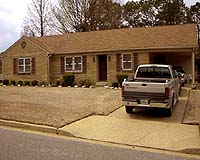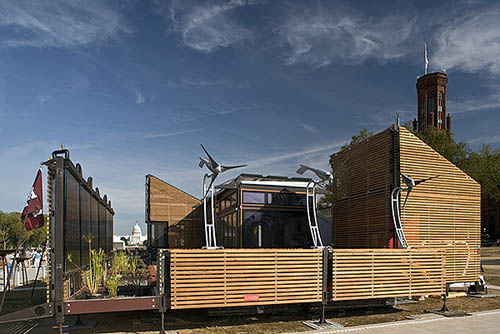Believe it or not typical Concrete Products and single pane glass have the same R-Value – 1. That is because they readily give up heat because of their porus nature and in part because they are good conductors. There is a reason why castles were cold and dreary. An there is a reason why your basement is cool in the summer.
http://www.coloradoenergy.org/procorner/stuff/r-values.htm
R-Value Table
Insulation Values For Selected Materials
Construction Materials
| Concrete Block 4″ | 0.80 | |
| Concrete Block 8″ | 1.11 | |
| Concrete Block 12″ | 1.28 | |
| Brick 4″ common | 0.80 | |
| Brick 4″ face | 0.44 | |
| Poured Concrete | 0.08 |
I should mention that the poured concrete number is by the inch. It takes no math wiz to see that 20 inches of typical concrete still is an R-value of slightly less than 1.
But you ask, “Mr. CES Man why is that important?” It is important in the Residential Market because a lot of us have basements made out of concrete, masonary block or a combination of the two.
According to the government:
U.S. Department of Energy – Energy Efficiency and Renewable Energy
A Consumer’s Guide to Energy Efficiency and Renewable Energy
Basement Insulation
A properly insulated basement can help reduce your energy costs. However, basement walls are one of the most controversial areas of a house to insulate and seal. You need to carefully consider the advantages and disadvantages, not to mention moisture control.
Before insulating or deciding whether to add insulation to your basement, first see our information about adding insulation to an existing house or selecting insulation for new home construction if you haven’t already.
| U.S. Cities | R-10* | R-2-** |
|---|---|---|
| Buffalo, NY | $350 | $390 |
| Minneapolis, MN | $400 | $450 |
| St. Louis, MO | $250 | $290 |
*Such as 2 to 3 inches of exterior foam insulation.
**Such as with most insulated concrete forms.
Annual Energy Savings
The energy cost savings of basement wall insulation vary depending on the local climate, type of heating system, fuel cost, and occupant lifestyle. Typical annual cost savings by R-value in a few U.S. cities are provided in the table above for a 1,500 square-foot home with a conditioned basement heated by natural gas ($0.72/therm).
Advantages and Disadvantages
In most cases, a basement with insulation installed in the exterior basement walls should be considered a conditioned space. Even in a house with an unconditioned basement, the basement is more connected to other living spaces than to the outside. This connection makes basement wall insulation preferable to insulating the basement ceiling.
Compared to insulating the basement ceiling, insulating basement walls has the following advantages:
- Requires less insulation (1,350 square feet of wall insulation for a 36 x 48-foot basement with 8-foot walls, compared with 1,725 ceiling)
- More easily achieves continuous thermal and air leakage boundaries because basement ceilings typically include electrical wiring, plumbing, and ductwork.
- Requires little, if any, increase in the size of the heating and cooling equipment. The heat loss and air leakage through the basement ceiling is similar to that through the exterior walls of the basement.
These are some other advantages of insulation on exterior basement walls:
- Minimizes thermal bridging and reducing heat loss through the foundation
- Protects the damp-proof coating from damage during backfilling
- Serves as a capillary break to moisture intrusion
- Protects the foundation from the effects of the freeze-thaw cycle in extreme climates
- Reduces the potential for condensation on surfaces in the basement
- Conserves room area, relative to installing insulation on the interior.
:}
Leave it to the Bush administration to say that insulation is controversial. If you are building a new home there is not a doubt that you should insulate the exterior basement walls. In fact if you are building a pad style house, you should insulate underneath the pad with some kind of insulative mixed cement. I am not sure the whole pad needs to be of that type concrete. It is expensive but if you can afford it can’t hurt.
http://www.askthebuilder.com/N2-Basement_Insulation.shtml
Mr. Builder Man makes the point that the only place to insulate in the basement is on the walls. He adds:
Because your basement walls are conducting cold into your basement via the cold ground outside, it might be worthwhile to add insulation over your exposed masonry foundation. You can choose to use closed-cell foam or fiberglass if you choose. But be sure you check with your local building department as some insulations that are flammable – such as closed cell foam – must be covered with drywall or other approved material to prevent rapid fire/flame spread.
:}
He finishes on a note that warms the heart of a die hard conservationist:
I would also inspect the juncture between the wood framing and the top of the concrete foundation. Do this on a windy day and try to feel for air leaks. Air infiltration can be a major drain on your heating budget. Pack insulation in any cracks you discover or caulk them to stop air flow.
All these people agree:
www.homeimprovementweb.com/
www.homeenvy.com/db/0/750.html
www.owenscorning.com/around/
www.doityourself.com/scat/basementinsulation
www.thisoldhouse.com/toh/
www.state.mn.us/mn/externalDocs/
www.builtgreen.org/articles/0208_mold.htm
I prefer a radical approach hire a Backhoe and dig out the dirt around your basement. Then you can apply ridgid waterproof R Board to the outside of the basement. Then you can backfill with gravel for drainage and tap down some dirt. Your house will thank you for ever. For those people that have a house already resting on a pad, you have one heck of a problem on your hands.
:}








